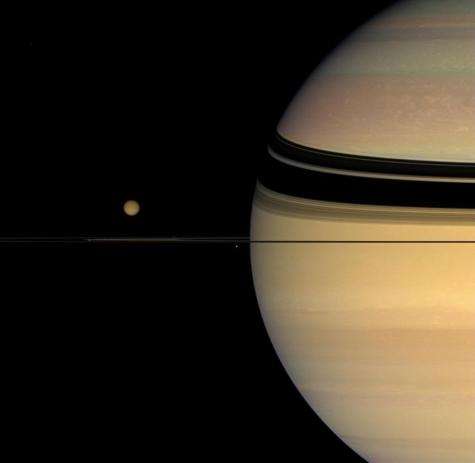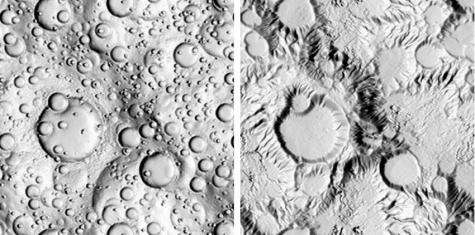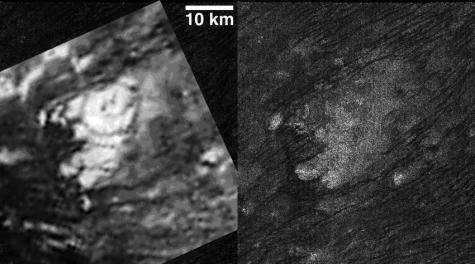Scientists theorize Titan shaped by weather, not ice volcanoes

(PhysOrg.com) -- Have the surface and belly of Saturn's smog-shrouded moon, Titan, recently simmered like a chilly, bubbling cauldron with ice volcanoes, or has this distant moon gone dead? In a newly published analysis, a pair of NASA scientists analyzing data collected by the Cassini spacecraft suggest Titan may be much less geologically active than some scientists think.
In the paper, published in the April 2011 edition of the journal Icarus, scientists conclude Titan's interior may be cool and dormant and incapable of causing active ice volcanoes.
"It would be fantastic to find strong evidence that clearly shows Titan has an internal heat source that causes ice volcanoes and lava flows to form," said Jeff Moore, lead author of the paper and a planetary scientist at NASA's Ames Research Center, Moffett Field, Calif. "But we find that the evidence presented to date is unconvincing, and recent studies of Titan’s interior conducted by geophysicists and gravity experts also weaken the possibility of volcanoes there."
Scientists agree that Titan shows evidence of having lakes of liquid methane and ethane, and valleys carved by these exotic liquids, as well as impact craters. However, a debate continues to brew about how to interpret the Cassini data about Titan. Some scientists theorize ice volcanoes exist and suggest energy from an internal heat source may have caused ice to rise and release methane vapors as it reached Titan’s surface.
But in the new paper, the authors conclude that the only features on Titan’s surface that have been unambiguously identified were created by external forces – such as objects hitting the surface and creating craters, wind and rain pummeling its surface, and the formation of rivers and lakes.
"Titan is a fascinating world," said Robert Pappalardo, a research scientist at NASA's Jet Propulsion Laboratory, Pasadena, Calif., and former Cassini project scientist. "Its uniqueness comes from its atmosphere and organic lakes, but in this study, we find no strong evidence for icy volcanism on Titan."

In December 2010, a group of Cassini scientists presented new topographic data on an area of Titan called Sotra Facula, which they think makes the best case yet for a possible volcanic mountain that once erupted ice on Titan. Although Moore and Pappalardo do not explicitly consider this recent topographic analysis in their paper, they do not find the recent analysis of Sotra Facula to be convincing so far. It remains to be seen whether ongoing analyses of Sotra Facula can change minds.
Titan, Saturn's largest moon, is the only known moon to have a dense atmosphere, composed primarily of nitrogen, with two to three percent methane. One goal of the Cassini mission is to find an explanation for what, if anything, might be maintaining this atmosphere.
Titan's dense atmosphere makes its surface very difficult to study with visible-light cameras, but infrared instruments and radar signals can peer through the haze and provide information about both the composition and shape of the surface.
"Titan is most akin to Jupiter's moon Callisto, if Callisto had weather," Moore added. "Every feature we have seen on Titan can be explained by wind, rain, and meteorite impacts, rather than from internal heating."

Callisto is almost the exact same size as Titan. It has a cratered appearance and because of its cool interior, its surface features are not affected by internal forces. Moore and Pappalardo conclude that Titan also may have a cool interior, with only external processes like wind, rain and impacts shaping its surface."
The Cassini spacecraft, currently orbiting Saturn, continues to make fly-bys of Titan. Scientists will continue to explore Titan's mysteries, including investigations of the changes in the landscapes.
Provided by JPL/NASA





















